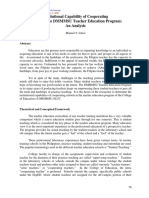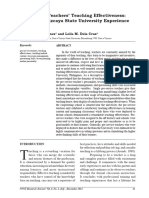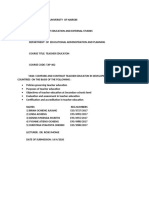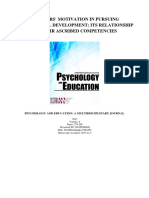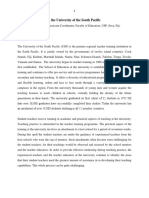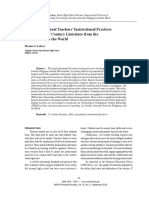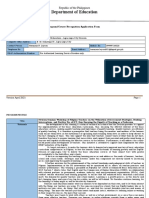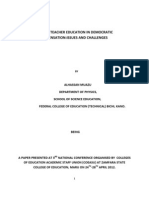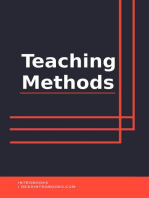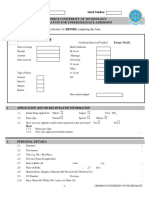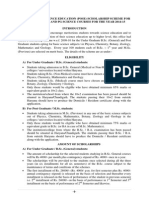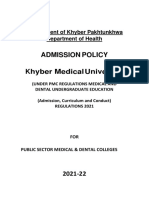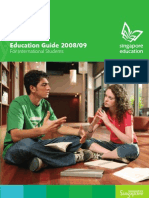Teacher Education in Finland
Teacher Education in Finland
Uploaded by
Rudolf DebrezinCopyright:
Available Formats
Teacher Education in Finland
Teacher Education in Finland
Uploaded by
Rudolf DebrezinOriginal Description:
Original Title
Copyright
Available Formats
Share this document
Did you find this document useful?
Is this content inappropriate?
Copyright:
Available Formats
Teacher Education in Finland
Teacher Education in Finland
Uploaded by
Rudolf DebrezinCopyright:
Available Formats
Teacher education
in Finland
Finland’s high level of education and competence is based on
high-quality teacher education. The profession of a teacher
is regulated, and the qualifications required from teachers are
defined in legislation.
The statutes in question list the studies, kindergarten teachers, whose qualification of independent problem-solving and
qualifications and work experience estab- requirements include a bachelor’s degree. have the capacity to utilise the most
lished as qualification requirements for In Finland, teacher education is a popu- recent research in the fields of education
different teaching posts. In Finland, lar field of study, and higher education and the subjects taught. Using these skills,
the majority of teachers (some 88%) fulfil institutions are in a position to select the the teacher is able to independently de-
the requirements set for their position. most well-suited and the most motivated velop both him or herself as a teacher and
The Finnish National Board of Education applicants for their programmes. his or her work community in cooperation
issues decisions concerning the recogni- Higher education institutions decide with the rest of the staff of the educa-
tion of foreign teaching qualifications in on student admissions and admission tional institution.
Finland. criteria independently. Entrance tests of Teacher education offered at
universities are used to assess aspects universities provides the student with
Predominantly female such as academic studying skills and capabilities for acting independently as a
profession aptitude for the teacher, instruc-
Approximately 63,500 teachers work in profession. In the tor and educator.
basic education and the upper secondary admissions process Higher education The objective
level (general upper secondary school and for professional
institutions decide of professional
vocational education and training) and teacher education, teacher education
in liberal adult education. The majority the areas assessed independently on the is to provide the
of teachers are women. Out of teachers include competence contents of teacher student with the
working in basic education, more than and expertise in skills and knowl-
70% are women; the corresponding figure the specific field of
education. edge to guide the
for vocational education and training is teaching, to be dem- learning of differ-
slightly more than a half. The majority of onstrated through ent students and
teachers are employed by municipalities. work experience and qualifications. the capabilities to develop his or her field
In Finland, higher education insti- of teaching taking into account develop-
Higher education institutions tutions decide independently on the ments in the world of work and different
decide on student admissions and contents of teacher education. The link professions.
the contents of the education between teaching and research is em- All teacher education also involves
themselves phasised in the education. The objective pedagogical studies and guided teaching
In Finland, teachers are required to have is to produce teachers with a research- practice, which is implemented in the
a master’s degree with the exception of orientation in their work who are capable universities’ own schools for teaching
Ministry of Education and Culture | Teacher education in Finland | 1/2014
practice or other schools nominated for content of teacher education include Regular in-service education
the purpose. Guided teaching practice the teaching and guidance of students The work performed by teachers is
involves the giving of lessons, guidance requiring a greater level of support, the demanding and requires regular in-
discussions and familiarisation with tasks development of learning environments, service education and the opportunity
and responsibilities related to various the utilisation of information and for further education. The parties
issues arising in the everyday life of communication technology, issues related responsible for the in-service education
schools. The aim is for students in teach- to a multicultural society, cooperation of teaching staff are the teachers
er education to become independent and between school and home and themselves and their employers, most
responsible teachers and learn self-devel- cooperation with the world of work. commonly municipalities. The employer
opment, become increasingly proficient is responsible for education based on the
in their own subject and learn to develop The work of teachers is very collective agreement for public servants;
the work community in cooperation with independent the minimum duration of this education
other members of teaching staff. In Finland, teachers have many profes- is three working days outside of school
sional freedoms and opportunities to days per academic year.
Teacher education is developed impact their work and the development In addition to the employer, also
constantly of their work community. Teachers have the Ministry of Education and Culture
The qualitative and quantitative the power to decide which teaching supports the in-service education
development needs of teacher methods and learning materials they of teachers. The objective of state-
education are explored regularly want to use. The Finnish system is based financed in-service education is to
through various evaluations, forecasts on trust in teachers and teacher educa- provide principals and teachers with
and data collection. tion. In Finland, no national evaluation or equal opportunities to develop their
Focus points in developing the registration of teachers takes place. competence.
Applicants who took part in phase 1 entrance test for Finnish-language
class teacher education and those selected for class teacher education
2011 2012 2013
Applicants who participated in the national test 8 856 11 976 12 493
Applicants selected for the education 811 879 886
Ministry of Education and Culture | Teacher education in Finland | 1/2014
You might also like
- Institutional Capability of Cooperating Schools of The DMMMSU Teacher Education Program: An AnalysisDocument14 pagesInstitutional Capability of Cooperating Schools of The DMMMSU Teacher Education Program: An AnalysisKenneth BoquingNo ratings yet
- NVSURJ Vol.1 02 2014 5Document12 pagesNVSURJ Vol.1 02 2014 5Jerry F. Abellera Jr.No ratings yet
- Q. NO 01 Describe The Concept and Scope of Teacher Education. How Teacher Education of Pakistan Is Similar To USA and Different From Teacher Education of India? Answer Concept of Teacher EducationDocument17 pagesQ. NO 01 Describe The Concept and Scope of Teacher Education. How Teacher Education of Pakistan Is Similar To USA and Different From Teacher Education of India? Answer Concept of Teacher EducationShafin MaaniNo ratings yet
- Comparison and Contract of Teacher Education in Finland and KenyaDocument10 pagesComparison and Contract of Teacher Education in Finland and Kenyayvonneagatha2016No ratings yet
- The RPMS-Based Performance of Public Elementary School Master Teachers in The Schools Division of MarinduqueDocument17 pagesThe RPMS-Based Performance of Public Elementary School Master Teachers in The Schools Division of MarinduquePsychology and Education: A Multidisciplinary JournalNo ratings yet
- 1 - Amjad and InamullahDocument14 pages1 - Amjad and InamullahMansoor AliNo ratings yet
- 05 RaymundoDocument8 pages05 RaymundoSheena Marie Sison DugayoNo ratings yet
- Dfe1652f 1633783000697Document20 pagesDfe1652f 1633783000697RubeenaNo ratings yet
- Philippine Professional Standards For TeachersDocument2 pagesPhilippine Professional Standards For TeachersDevine GabatNo ratings yet
- EDUC103 Module 2 Lesson 1Document6 pagesEDUC103 Module 2 Lesson 1Roderick Viloria MiloNo ratings yet
- Sample Chapter 1 RC103 EmsDocument28 pagesSample Chapter 1 RC103 EmsJonary P. JarinaNo ratings yet
- Inquiry On The Lived Experiences of Teachers Handling Learners With Special Needs in The Division of Biñan CityDocument10 pagesInquiry On The Lived Experiences of Teachers Handling Learners With Special Needs in The Division of Biñan CityPsychology and Education: A Multidisciplinary JournalNo ratings yet
- Maryam Zahoor ... Final SynopsisDocument14 pagesMaryam Zahoor ... Final Synopsiseishailyas2019No ratings yet
- Teachers' Motivation in Pursuing Professional Development Its Relationship To Their Ascribed CompetenciesDocument26 pagesTeachers' Motivation in Pursuing Professional Development Its Relationship To Their Ascribed CompetenciesPsychology and Education: A Multidisciplinary JournalNo ratings yet
- 01 Agriculture SyllabusDocument58 pages01 Agriculture SyllabuskingmambulasaNo ratings yet
- Trusted Professionals: Teachers in FinlandDocument2 pagesTrusted Professionals: Teachers in FinlandDayang EzzatiNo ratings yet
- 196781-Article Text-496192-1-10-20200615 PDFDocument15 pages196781-Article Text-496192-1-10-20200615 PDFTerriah GerhardNo ratings yet
- Renu PublicationDocument11 pagesRenu PublicationManel Pidas Da DulceNo ratings yet
- 2 - The Nature of Teacher DevelopmentDocument17 pages2 - The Nature of Teacher DevelopmentRiani pohanNo ratings yet
- Concept PaperDocument5 pagesConcept PaperMA. GLAIZA ASIANo ratings yet
- 2 PBDocument11 pages2 PBWinarto WinartoNo ratings yet
- Edci 411 Teacher EducationDocument40 pagesEdci 411 Teacher EducationBrenda OkeyoNo ratings yet
- University of Caloocan City Graduate SchoolDocument35 pagesUniversity of Caloocan City Graduate SchoolSheilavee Taguinod100% (1)
- Implications of FPK, FPG & Special EducationDocument11 pagesImplications of FPK, FPG & Special EducationHidayah RazipNo ratings yet
- Kusum Prakash On Teacher Training at The University of The South PacificDocument6 pagesKusum Prakash On Teacher Training at The University of The South PacificPapers and Powerpoints from UNTL-VU Joint Conferenes in DiliNo ratings yet
- Agriculture Model Answers - KayiraDocument62 pagesAgriculture Model Answers - KayiraeleazerellingsNo ratings yet
- The Instructional Supervisory Competencies of Master Teachers in The Division of Rizal: Inputs For An Enhanced Professional Development ProgramDocument24 pagesThe Instructional Supervisory Competencies of Master Teachers in The Division of Rizal: Inputs For An Enhanced Professional Development ProgramPsychology and Education: A Multidisciplinary JournalNo ratings yet
- Elements of Teaching and LearningDocument7 pagesElements of Teaching and LearningRamil AdarnaNo ratings yet
- Senior High School Teachersrsquo Instructional Practicesin Teaching 21 ST Century Literaturefromthe Philippinesandthe WorldDocument13 pagesSenior High School Teachersrsquo Instructional Practicesin Teaching 21 ST Century Literaturefromthe Philippinesandthe WorldJojames GaddiNo ratings yet
- Educ 102 MidtermDocument43 pagesEduc 102 MidtermellaineNo ratings yet
- Importance of Teacher Education: Sharmila SagarDocument4 pagesImportance of Teacher Education: Sharmila Sagarkhaaansubhan7No ratings yet
- Activity 2 in EED 114 PDFDocument3 pagesActivity 2 in EED 114 PDFPrincess Roncal SaludaresNo ratings yet
- Evaluation of The Challenges Facing Prospective Teachers During Teaching Practice For Effective Teacher Production in Tertiary Education in Anambra State, NigeriaDocument5 pagesEvaluation of The Challenges Facing Prospective Teachers During Teaching Practice For Effective Teacher Production in Tertiary Education in Anambra State, NigeriaInternational Journal of Innovative Science and Research TechnologyNo ratings yet
- x01 - Science and Technology SyllabusDocument81 pagesx01 - Science and Technology Syllabussilionfrank9No ratings yet
- 833 2278 1 PB PDFDocument13 pages833 2278 1 PB PDFJohnMedinaNo ratings yet
- x03 - Module 2 301117Document100 pagesx03 - Module 2 301117priscamthobwaNo ratings yet
- DR NasirDocument6 pagesDR Nasirrohaali044No ratings yet
- Exploring Junior High School EFL Teachers Training Needs of Assessment LiteracyDocument14 pagesExploring Junior High School EFL Teachers Training Needs of Assessment LiteracyradenhibNo ratings yet
- 8612 Assignment 01 AwaisDocument28 pages8612 Assignment 01 AwaisawaisNo ratings yet
- 1st 4th Quarter First Sem Educ 5Document361 pages1st 4th Quarter First Sem Educ 5shainell121100% (1)
- 8612 Assignment IDocument18 pages8612 Assignment Isajidaruqaya760No ratings yet
- Comparative Education Course Module Output Final MEDocument21 pagesComparative Education Course Module Output Final MEAldrin Jon Madamba, MAED-ELMNo ratings yet
- FORM R.1 Recognition Application Form FinalDocument18 pagesFORM R.1 Recognition Application Form FinalMarilyn Torremocha OmpadNo ratings yet
- Mainstreaming Learners With Special Educational Needs in Regular Classes: Its Impact On Teachers' Attitude and Self-Efficacy Towards InclusionDocument22 pagesMainstreaming Learners With Special Educational Needs in Regular Classes: Its Impact On Teachers' Attitude and Self-Efficacy Towards InclusionPsychology and Education: A Multidisciplinary JournalNo ratings yet
- Context and Rationale: Collaborative Learning Approach of Teachers On Student'S Achievement and PerformanceDocument15 pagesContext and Rationale: Collaborative Learning Approach of Teachers On Student'S Achievement and PerformanceAnnalyn Garingan CruzNo ratings yet
- Unit 1Document14 pagesUnit 1Aliza ArifNo ratings yet
- AbstractDocument12 pagesAbstractAlhassan MuazuNo ratings yet
- Educ102 PPT Week2Document28 pagesEduc102 PPT Week2Jay VaronaNo ratings yet
- Chapter 1Document10 pagesChapter 1russeljohnrussel277No ratings yet
- 05_EFS module 5. final refinementDocument65 pages05_EFS module 5. final refinementwonganiyewochipetaNo ratings yet
- Investigating Kurdish Efl Student Teachers' Classroom Teaching Experiences and Problems During Teaching PracticeDocument10 pagesInvestigating Kurdish Efl Student Teachers' Classroom Teaching Experiences and Problems During Teaching PracticeAsala hameedNo ratings yet
- PJHSS, Vol10, No3, 2022 - 22Document7 pagesPJHSS, Vol10, No3, 2022 - 22Ruqia IbraheemNo ratings yet
- Enhanced Teacher Education Curriculum Anchored On OBEDocument15 pagesEnhanced Teacher Education Curriculum Anchored On OBERuby ConcepcionNo ratings yet
- 1._Education_Foundation_Module_1Document103 pages1._Education_Foundation_Module_1alinafe mphandeNo ratings yet
- Lesson 2: Enchanced Teacher Education Curriculum Anchored On OBEDocument24 pagesLesson 2: Enchanced Teacher Education Curriculum Anchored On OBEAlyssa AlbertoNo ratings yet
- Teachers' KSAs in Handling LSENs: Basis For Localized Inclusive Education ProgramDocument8 pagesTeachers' KSAs in Handling LSENs: Basis For Localized Inclusive Education ProgramPsychology and Education: A Multidisciplinary JournalNo ratings yet
- Maharashtra Association of Schools of Architecture (Masa)Document32 pagesMaharashtra Association of Schools of Architecture (Masa)a_j_sanyal259No ratings yet
- 16PGAD0242 Athira SasiDocument5 pages16PGAD0242 Athira SasiMountsinai CscNo ratings yet
- Chinhoyi University of Technology Application For Undergraduate AdmissionDocument4 pagesChinhoyi University of Technology Application For Undergraduate AdmissionJohn PinchosNo ratings yet
- WB Exams PDFDocument99 pagesWB Exams PDFprsnjt11No ratings yet
- Kami Export - Worksheet-College Research 4Document1 pageKami Export - Worksheet-College Research 4api-535006987No ratings yet
- Philippine Normal UniversityDocument2 pagesPhilippine Normal UniversityD'Jhoy FaeldanNo ratings yet
- Employeepolicyhandbook01 11 202128420221310762Document19 pagesEmployeepolicyhandbook01 11 202128420221310762Virat PandeyNo ratings yet
- IGNOUDocument12 pagesIGNOUparkesh kumarNo ratings yet
- Chinese Language Program For International Students - Fall 2021Document3 pagesChinese Language Program For International Students - Fall 2021Daniel YonathanNo ratings yet
- POSE Scholarship Scheme For 2014-15Document4 pagesPOSE Scholarship Scheme For 2014-15AnweshaBoseNo ratings yet
- KPK Admission Policy For MBBS &BDS 2021-22i 2Document51 pagesKPK Admission Policy For MBBS &BDS 2021-22i 2Sam khanNo ratings yet
- GNM Exam CriteriaDocument4 pagesGNM Exam CriteriaRAMARNo ratings yet
- The Effect of Curriculum-Based Exit Exam Systems On Student The Effect of Curriculum-Based Exit Exam Systems On Student Achievement AchievementDocument27 pagesThe Effect of Curriculum-Based Exit Exam Systems On Student The Effect of Curriculum-Based Exit Exam Systems On Student Achievement AchievementasseralemuNo ratings yet
- Destination NetherlandsDocument12 pagesDestination NetherlandsYogesh CaulleechurnNo ratings yet
- KTU B.tech Draft Regulation 2019 Circulation FinalDocument17 pagesKTU B.tech Draft Regulation 2019 Circulation FinalRoy Sathyadevan100% (1)
- Prospectus 2010Document31 pagesProspectus 2010rvks007No ratings yet
- Announcement SoalDocument16 pagesAnnouncement SoalArdanaad 99No ratings yet
- A Many Facet Rasch Analysis Comparing Essay Rater Behavior On - 2016 - AssessinDocument11 pagesA Many Facet Rasch Analysis Comparing Essay Rater Behavior On - 2016 - Assessinshuyu Lo100% (1)
- SA Defence Intelligence ApplicationDocument1 pageSA Defence Intelligence ApplicationLesedi MasisiNo ratings yet
- SOP Sample For Canada!Document2 pagesSOP Sample For Canada!Surid AnirbanNo ratings yet
- EthiopiaDocument2 pagesEthiopiaTeddy AdaneNo ratings yet
- Admissions Guide PDFDocument38 pagesAdmissions Guide PDFSonny JimNo ratings yet
- UOG Admission Policy Fall 2022 Undergraduate 5th Sem InductionDocument27 pagesUOG Admission Policy Fall 2022 Undergraduate 5th Sem InductionYNYkNo ratings yet
- Singapore Education Guide 2008 09Document357 pagesSingapore Education Guide 2008 09ttphyoe100% (1)
- Italy Admision Procedure and Visa GuidanceDocument4 pagesItaly Admision Procedure and Visa GuidanceSiva Prasad NandyalaNo ratings yet
- Guide 1 To Online Application System: MSC in Engineering ProgrammesDocument20 pagesGuide 1 To Online Application System: MSC in Engineering ProgrammesSuperhypoNo ratings yet
- Credential Guide 2023-2024 - Website VersionDocument11 pagesCredential Guide 2023-2024 - Website VersionjgonzaloNo ratings yet
- Higher Education Problems and SolutionsDocument4 pagesHigher Education Problems and SolutionsUch SasNo ratings yet
- Int Baccalaureate Scholarship 2024 25Document3 pagesInt Baccalaureate Scholarship 2024 25sofiaNo ratings yet
- ICAR Counseling SRF BrochureDocument70 pagesICAR Counseling SRF BrochureSharat PrabhakaranNo ratings yet

